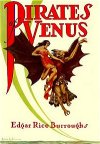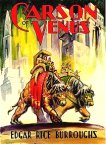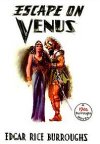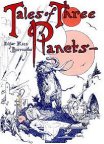Land, Sea and Air
Duare had escaped from the castle of the repulsive Skor,
apparently by jumping into the river. But how did Duare learn to swim?
She had spent her life in the tall trees of Vepaja.
This fact had occurred to Carson and apparently, in their
adventures in Noobol together up to that time, there had been no occasion
to take a dip, for he was ignorant of any swimming abilities she might
have. In Chapter 9 of Lost on Venus, Carson worried, "I did not
know that Duare could swim nor that she could not, but the chances were
highly in favor of the latter possibility, since Duare had been born and
reared in the tree city of Kooaad a thousand feet or more above the ground."
In Lost, one can only guess about Duare's ability
to swim, since we don't have her first-person account of what happened.
But in Escape on Venus, we learn for sure that she can hold her
own in the water.
First, in the adventure in Mypos, Carson rescued Duare
by blasting Tyros, the jong, and, as warriors closed in, they escaped under
water. Carson narrated: "I led her to the mouth of the tunnel and followed
her in. I must have been wrong in my estimate of the distance to the lake.
It was far more than a hundred yards. I marveled at Duare's endurance,
for I was almost all in and virtually at my last gasp, had I dared to gasp,
when I saw light shining from above. As one we shot to the surface; and
as our heads broke it, almost simultaneously, Duare flashed me a reassuring
smile. Ah, what a girl!" EV, Chapter 16
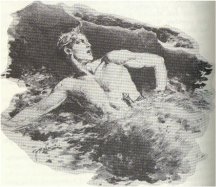
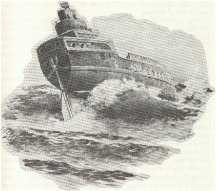
Later in Escape, when Duare was stuck with Vik-Yor,
the amoeba man from Voo-ad, she had to swim to keep the precious anotar
from being borne away in a river current. "She looked into the deep flowing
water. What ravenous monsters might lurk beneath that placid surface! To
lose the anotar, was to forfeit her life and Carson's as well. It was that
last thought that sent her into the midst of the hidden dangers of the
flood. Striking out boldly, she swam strongly toward the anotar. A slimy
body brushed against her leg. She expected great jaws to close upon her
next, but nothing happened. She closed in upon the anotar; she seized a
pontoon and climbed to the wing; she was safe!" EV, Chapter 40
It's hard to imagine Duare being allowed down from the
trees in Vepaja to take a few swimming lessons in a creek or a lake. But
those trees were pretty big around. Maybe in his stay in the tree city,
Carson never got a chance to visit the tree with the Olympic-size swimming
pool hewn out of the inside of a towering Amtorius Sequoius! But if Kooaad
did not have some kind of swimming facility, then Carson must have eventually
taught Duare to take a dip, or she had learned by the "sink or swim" method.
And maybe that last option is, after all, the way she survived when she
took a leap into the river from the wall of Skor's castle!
Duare eventually proved to be a worthy companion of Carson.
One of the best decisions he made was to teach her how to fly the anotar,
so that she was his equal in its operation. Her knowledge came in handy
in their adventures during the war in Amlot in Carson of Venus.
In Escape, after Carson was captured and taken
to Brokol, Duare flew the anotar from Japal to distant Brokol and was able
to rescue her man from certain death in a Roman games-type stadium.
Later, when she escaped from the Voo-ad museum of natural
history, she was able to select the right parts from the anotar repair
kit and reattach the propeller properly while pausing to shoot down attackers,
in order to escape.
When Carson and Duare shot to the surface in Myposa, he
had thought: "In two worlds; yes, even in all the Universe I doubt that
there is her like."
John Carter of Mars, husband of "the incomparable Dejah
Thoris," would argue. But at least these bold beauties reside on different
planets, millions of miles away from each other, where they can't try to
scratch each other's eyes out to determine who's No. 1!
The Problem with People
Pirates of Venus
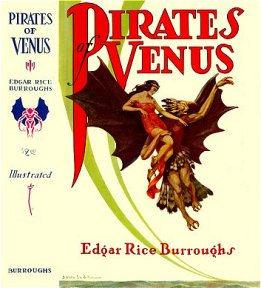 "Where
there are no men, one is comparatively safe, even in a world of savage
beasts." —Carson Napier, EV, Chapter 3
"Where
there are no men, one is comparatively safe, even in a world of savage
beasts." —Carson Napier, EV, Chapter 3
On a planet like Amtor, there are few nations which warmly
welcome strangers. And even the more accommodating peoples -- like those
of Kooaad in Vepaja and Ha-vatoo in Noobol -- while friendly to a degree,
have the mechanism in place to eliminate any wayfarers who didn't measure
up. Places such as Sanara and Japal were hospitable, thanks to the fact
that Carson made friends with a leading person of those lands before attempting
to enter their cities.
The first totally unfriendly land the reader is introduced
to is Thora, although Carson only hears about it but never actually gets
there. From ERB's description, it sounds as if Thora is a Venusan equivalent
of Earth's Communists. The official name of the country, The Free Land
of Thora, is somewhat reminiscent of communist nation titles, such as The
Peoples Republic of China.
Like the Communist appellation of "comrade," they refer
to each other as "friend" (LV, Chapter 1) and to a ruler as an ongyan,
Venusan for "great friend" (LV, 1) The name of Moosko, the Ongyan,
suggests Moscow.
Zog, one of Carson's fellow pirates aboard the Sofal,
said he had enjoyed more freedom as a slave than as a so-called free-man
of Thora: "Then, I had one master; now I have as many masters as there
are government officials, spies, and soldiers, none of whom cares anything
about me, while my old master was kind to me and looked after my welfare."
PV, Chapter 9.
Lost on Venus
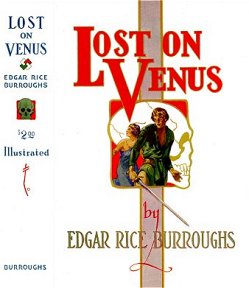 It
might seem that Thora would play a leading adversarial role in Carson's
adventures, but as it turns out, his closest brush with the Thorists came
from his brief time aboard a Thorist ship, on which he led a successful
mutiny (Pirates), and a short time in the Noobolian city of Kapdor,
which was in league with Thora (Lost). His adventures on Amtor never
took him to the nation of Thora itself.
It
might seem that Thora would play a leading adversarial role in Carson's
adventures, but as it turns out, his closest brush with the Thorists came
from his brief time aboard a Thorist ship, on which he led a successful
mutiny (Pirates), and a short time in the Noobolian city of Kapdor,
which was in league with Thora (Lost). His adventures on Amtor never
took him to the nation of Thora itself.
Noobol was a big continent and had room for more than
just the Thorist-linked lands. Duare, reflecting on her geography lessons,
said, "It is a sparsely settled land reaching, it is supposed, far into
Strabol, the hot country, where no man may live. It is filled with wild
beasts and savage tribes. There are scattered settlements along the coast,
but most of these have been captured or reduced by the Thorists; the others,
of course, would be equally dangerous, for they would consider all strangers
as enemies." (LV, Chapter 3)
After escaping through sheer luck from a tribe of cannibalistic
kloonobargan, Carson and Duare made their way to the land of Morov, first
ending up in Skor's castle full of mindless zombies, and later in Skor's
city of Kormor, which was similarly populated.
Both the Thorist city of Kapdor and Skor's domains of
the dead were depressing places.
Through the brief look he had at the city of Noobol, Carson
painted an unflattering picture. "There were many people on the streets
of Kapdor, but they seemed dull and apathetic. Even the sight of a blond-haired,
blue-eyed prisoner aroused no interest within their sodden brains. To me
they appeared like beasts of burden, performing their dull tasks without
the stimulus of imagination or of hope". LV, Chapter 1
The people in Skor's castle were de-scribed in a similarly
depressing way: "Her eyes were glazed and staring. She moved with a slow,
awkward shuffle. And now, behind her, came two men. They were much as she;
there was something indescribably revolting about all three." LV,
Chapter 7
Then there were the general surroundings. In Kapdor, Carson
saw that "the buildings for the most part were mean hovels of a single
story, but there were others that were more pretentious.... There were
a number of stone buildings facing the streets along which I was conducted;
but they were all box-like, unprepossessing structures with no hint of
artistic or imaginative genius." There was beauty in Kapdor, but it all
belonged to the headquarters of the regime.
Likewise, Lost, Chapter 7, was tell-titled as "The
Gloomy Castle." Carson reported, "The enclosure across which we passed
was barren except for the few trees that had been left standing. It was
littered with refuse of all descriptions and was unspeakably disorderly
and untidy.... The only spot from which any effort had been made to remove
the litter was a few hundred square feet of stone flagging before the main
entrance to the building."
If Burroughs was deliberately trying to compare the gloomy
people and surroundings of Communist-like Kapdor with the revenants and
habitat of Morov, then he succeeded. ERB makes his point: Life under Communism
is like a living death.
Skor tried to blithely explain away the dullness of his
subjects by saying his specimens were that way only because they were dull
people in life (LV, Chapter 9). If any of his "specimens" came from
Thorist regimes, he'd have a point.
One other city in Noobol was much nicer, depending on
one's definition of nice. Havatoo appeared to be a model city, Carson even
reflecting upon it as "Utopian." (CV, 16) Carson, temporarily traveling
with newly acquired sidekick Nalte, was welcomed there. The city seemed
to have solved all of the world's problems and people lived together in
peace and harmony. In fact, unhappiness was not tolerated in Havatoo. To
maintain that harmony, undesirables, such as the unintelligent or "four
strikes and you're out" wrong-doers (CV, 12), were "destroyed" for
the good of everyone else. It was a bit dicey for Carson because the leaders
at first decided to destroy him because of his poor breeding, but then
relented when he made a chance remark about his space travel and they realized
he could contribute to their culture by becoming a teacher of astronomy.
As a side-line, Napier introduced the concept of flying machines, the airplane.
When Carson rescued Duare from Kor-mor and brought her
to Havatoo, their stay was short-lived -- the Havatooans decided
Duare had too much baggage, having lived for awhile in the dead city and
might have picked up who-knows-what in germs, bad habits, etc. So Carson
and Duare make a sudden aerial exit in the newly constructed anotar.
Carson of Venus
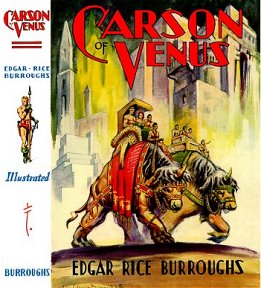 The
primary location of Carson of Venus was the kingdom of Korva in
the country of Anlap and centered around the cities of Sanara and Amlot.
But there was a brief interlude at the start of the book where Carson and
Duare played capture and escape with a tribe of people in which women dominated,
and the weak men answered to names such as Lula and Ellie.
The
primary location of Carson of Venus was the kingdom of Korva in
the country of Anlap and centered around the cities of Sanara and Amlot.
But there was a brief interlude at the start of the book where Carson and
Duare played capture and escape with a tribe of people in which women dominated,
and the weak men answered to names such as Lula and Ellie.
The Nazi-like Zani controlled the city of Amlot and were
besieging Sanara, but with Carson on the job the war was soon won with
the right side winning control, the right side being not only the more
decent guys, but also being the guys with whom Carson was friendly, and
he not only won the right for him and Duare to live in Sanara, but also
became the adopted son of Taman, the new jong of Sanara.
ERB began writing Carson in 1937 and the rise of
Adolf Hitler's Nazi Germany influenced him to bring a Nazi-like regime
in as Carson's new foe. The story is a masterpiece of satire, with ERB
using his Zani characters to show that much of Nazi practice was plain
silly, while -- at the same time -- illustrating the horror of it all.
On the silly side, ERB mocked the "Heil Hitler" salute
of the Nazis with the Zani cry: "Maltu Mephis." Men not in uniform had
to stand on their heads when Mephis passed by, probably a parody of the
Nazi salute. Carson referred to these customs as "the silly flubdub of
Zani ritual."
ERB's version of the goose-stepping Nazi troops was told
with a straight literary face, making it all the more hilarious: "The entire
company took three steps forward, hopped once on the left foot, took three
more steps forward, leaped straight up to a height of about two feet, and
then re-peated" and all the while the men chanted 'Maltu Mephis' in a sing-song
voice." Chapter 9
As Zerka and Carson watched the troops, Zerka told him
that this marching routine was the brainchild of Mephis himself. "I could
easily imagine that might be so," said Carson -- dryly, no doubt.
On the horror side, the rule of Mephis, like that of Hitler,
went hand in hand with "race purification."
In Carson, Chapter 7, Zani guards confronted a
man whose great-grandmother had been nursed by a woman of Ator. The guards
beat him, then dragged him away. Zerka explained the warped Zani rationale:
"The milk and therefore the blood of an Atorian entered the veins of an
ancestor, thereby contaminating the pure blood of the super race of Korva."
Later, the Zani officer Spehon gave a little more specificity
to the evils wrought by Atorians, saying the Zanis kill them "...because
they have large ears. We must keep the blood of the Korvans pure." (Chapter
9)
Mephis's ally, Muso, the corrupt jong who headed Sanara
until he was overthrown, was probably ERB's version of Italy's Mussolini.
As of the 1937 writing of Carson, Mussolini and Hitler were two
European strong men who were sometimes friendly, sometimes uneasy with
one another, but their alliance was solidified in 1938, making ERB's relation
between Muso and Mephis a bit prophetic.
The Del-Rey paperback of Carson of Venus shows
the copyright date as 1930 -- a neat trick for a book not written until
1937 and not published for the first time until 1938! Someone with only
the Del-Rey paperback might incorrectly conclude that all of ERB's Nazi-Zani
references were an amazing bit of prophetic writing!
ERB is indeed prophetic in Chapter 10, "The Prison of
Death," in which he describes the horrors of Zani imprisonment and torture,
and even includes a furnace where the bodies of the slain prisoners are
cremated. Though the Nazi persecution of the Jews and others was well under
way, in ever-escalating phases in the 30s, the death camps and furnaces
were a thing yet in the future when ERB wrote this novel.
Assigned to prison staff duty, Carson was given a tour
by a Zani guard who showed him an imprisoned doctor whose crime was that
he had alleviated the agony of an Atorian who was dying of an incurable
disease. "Can you imagine?" asked the guard. Carson's reply was far over
the head of the guard's discernment abilities: "I am afraid that my imagination
is permanently incapacitated. There are things that transcend the limits
of a normal imagination. Today you have shown me such things."
Escape on Venus
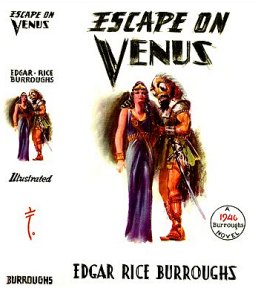 In
Escape
on Venus, Carson and Duare made it into the Northern Hemisphere of
Amtor and encountered peoples unknown to those in the south. Here were
a wild batch of denizens, with our lovebirds encountering and then escaping
from weird people after weird people.
In
Escape
on Venus, Carson and Duare made it into the Northern Hemisphere of
Amtor and encountered peoples unknown to those in the south. Here were
a wild batch of denizens, with our lovebirds encountering and then escaping
from weird people after weird people.
Unconventional methods of reproduction and/or child-rearing
were featured among three of the humanoid-type groups they encountered
in this volume.
First were the Myposans, who had fish heads and aquatic
qualities, especially when young. Carson, enslaved, was assigned to help
keep flying predators, called guy-pals, from plucking fish out of the pools.
But these weren't ordinary fish, they were the tadpole-like young who were
developing into amphibious, human-like adults.
ERB couldn't resist giving one of the adult "fish" the
name of Kod.
After escaping and finding refuge in Ja-pal, the land
of the Myposans' enemies, and totally human for a change, Carson was captured
and had a solo adventure in the land of green men, Brokol, where was found
the second instance of unusual child-rearing: The kids literally grew on
trees. Perhaps Brokol was short for broccoli.
Captives in Brokol were generally sacrificed to the fire
goddess. Before meeting her, Carson heard of her in a rare conversation
with a soldier of the normally taciturn Brokolians. "...she is not a woman;
she is more than a woman. She was not born of woman, nor did she ever hang
from any plants." EV, Chapter 24
After they came to the city, Carson learned firsthand
what that meant. As he and fellow prisoner Jonda, also a real human, were
marched to meet the goddess, they passed trees with little Brokolians,
ranging from one to 15 inches, some squirming like newborns. Jonda said
to Carson: "Pretty nearly ripe and about to fall off." EV, Chapter
25
Brokol was the only land Carson encountered where the
people had any kind of a religion, and that particular religion, in true
ERB fashion, was overthrown while Carson was there. Carson wasn't the one
responsible for doing the overthrowing, but his arrival in Brokol set in
motion the events which led to the downfall of the goddess, who was actually
a U.S. citizen who had probably been mysteriously transported there from
Earth. So, while she had certainly been born of a woman, she had never
hung from a tree.
Duare, meanwhile, had been safe among the tribesmen of
Timal, allies of Japal. After Kandor helped Duare repair the anotar, she
flew to Brokol in time to rescue Carson and Jonda from kloonobargan in
a Roman games-style arena.
Next in Escape, Carson and Duare fell into the
hands of the fine citizens of Voo-ad, most of whom had a red line centered
on their body. That red line was an element of the third unusual method
of reproduction that is found in this book. At a certain time in their
lives, these "amoeba people" reproduced by literally splitting along the
red line so each half could grow a new half.
Carson and Duare were tricked into eating a paralyzing
drug and then suspended in the city's Museum of Natural History as exhibits...
forever. Ero Shan, Carson's friend from Havatoo (Lost on Venus)
was also on display. So at least they had company.
Through the aid of a rebel named Vik-yor, Duare was re-ambulated
and escaped. Her plan was to come back and rescue Carson and Ero Shan but
first she had to go through a solo adventure with Vik-yor until she was
able to get the upper hand from him and return and effect the rescue.
After he and Ero Shan were freed, Carson released all
the other people in the museum, many of whom were warriors who were highly
irritated at having had to hang around for so long, and as the trio flew
out of the city the freed warriors sacked and torched it.
Finally in Escape, Carson, Duare and Ero Shan encountered
a land of four warring cities where combat engagements were fought with
huge land battleships. They were initially captured because of Carson's
stupidity in flying the anotar too close to their warships. He eventually
received a fitting punishment -- becoming a slave whose job was to shovel
manure.
After their adventures in that land, the trio had to escape
on the ground and went over the mountains riding in a small scout ship
swiped from the Falsa navy, aided by the Cloud People that Carson had be-friended.
The Wizard of Venus
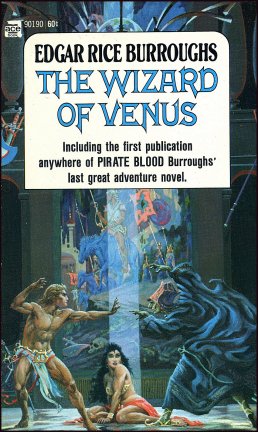 The
last adventure is The Wizard of Venus, in which Carson and Ero Shan
went on an excursion without Duare (Duare loathers rejoice) and ended up
in an Arthurian land where they had to outwit, outplay and outlast the
self-styled wizard, Morgas, in order to survive.
The
last adventure is The Wizard of Venus, in which Carson and Ero Shan
went on an excursion without Duare (Duare loathers rejoice) and ended up
in an Arthurian land where they had to outwit, outplay and outlast the
self-styled wizard, Morgas, in order to survive.
Here, for the first time on record since he got to Amtor,
Carson employed the illusionary telepathic powers he had first demonstrated
to ERB back in Pirates. And thus we learn why Carson hadn't used
his powers all along: It would have been too easy for him to get out of
his previous pickles and would have made for less exciting reading!

